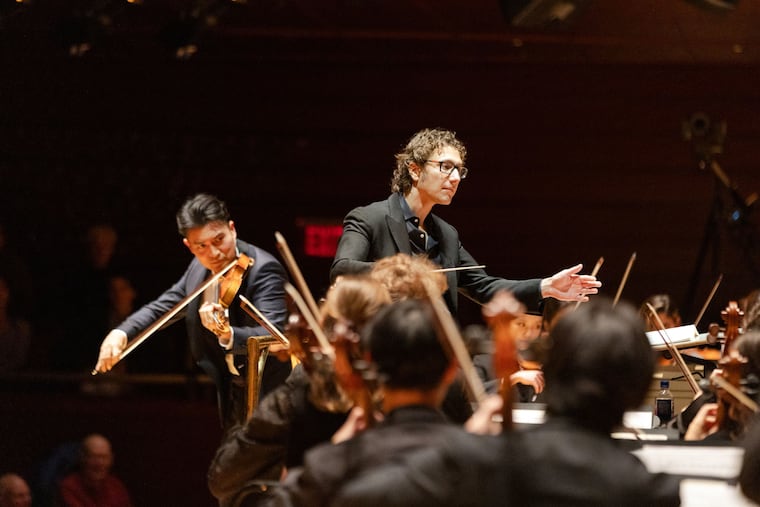Curtis plays Copland. Or, listening to the ‘Great American Symphony’ in fraught times.
The Curtis orchestra concert was a portrait of the school's century, and American music.

The character of a nation is enshrined not just in its documents and tested not only through its actions. American ideals are also encoded in sound, and Friday afternoon at the Kimmel Center, a student orchestra cut through our disorienting political moment with astonishing clarity.
The vehicle was Copland’s towering Symphony No. 3 — often called the great American symphony — and while support for the appellation has waxed and waned since the work’s premiere in 1946, it was striking to hear it now. Political commentary was hardly the intention of this Curtis Institute of Music orchestra concert, but fate provides the context, and a program planned long ago took on new meaning by the time it arrived onstage, postelection.
Philadelphia’s elite conservatory on Rittenhouse Square this season is celebrating its 100th year, and the orchestral assemblage of Copland and works by Barber and TJ Cole in Marian Anderson Hall was meant to form a portrait of the school’s central place in American music past and present.
This it did, and beautifully so. The crop of talent on stage was solidly accomplished, with at least a half dozen stars in the orchestral ranks. Individual oboists, a clarinetist, piccolo player and others proved ready for prime time.
Some pieces came with a full Curtis pedigree. Barber’s Violin Concerto exudes an incredible sense of ease — especially the sun-dappled first movement, where violinist Ray Chen and conductor Teddy Abrams (both Curtis grads) agreed not just on this music’s sense of liberty and bliss, but also the intensity of its more fervent passages. Chen is superb. He has interpretive insights and great presence, and if you’ve never heard an entirely satisfying performance of this work — both technically all zipped up and deeply expressive — here it was.
Cole attended Curtis eight decades after Barber, and the Louisville-based composer’s Death of the Poet had an echo of Barber’s famously mournful Adagio for Strings, though the stronger stylistic cousin was Schoenberg’s Transfigured Night. The orchestra’s strings, led by Curtis conducting fellow Yoann Combémorel, made Cole’s fine, transparent writing glow.
George Walker’s Lilacs, originally scheduled, was pulled from the concert because of insufficient rehearsal time, according to a Curtis spokesperson, and it’s a shame. The presence of the Pulitzer Prize-winning piece (1996) would have filled out the stylistic range of the school’s compositional lineage.
But the program’s big statement was the Copland symphony, whose connection comes by way of its most ardent advocate, Leonard Bernstein, a Curtis grad whose conducting was “the closest to what I had in mind when composing the piece,” Copland once said.
There was little in the Curtis’ program notes nudging the listener toward symbolism or deeper meanings, except for calling the work “unabashedly patriotic” and one that stands as a “lasting tribute to the strength and resilience of everyday Americans in the face of great adversity.”
And it’s true that Copland’s work isn’t programmatic, but it was started in wartime, in 1944, and finished in 1946. As an end-of-war piece, it was “intended to reflect the euphoric spirit of the country at the time,” the composer said. Most significantly, it melds material so convincingly folklike with that which simply speaks to basic goodness and humanity that it becomes a deeply moving evocation of a certain kind of America.
From the podium, Abrams — who is music director of the highly regarded Louisville Orchestra — quickly built the quiet, hometown warmth of the opening music into waves of optimism. You can hear the country in a state of inexorable ambition in the last minute of the piece, where the bold anvil strokes of violins, percussion, and other instruments set sparks flying.
The Curtis orchestra was plenty triumphant here, and in general did what this ensemble has always done, showing an occasional small slip, but also thrillingly blurring the line between a student and professional orchestra.
Is it possible to interpret the piece as anything but a monument to a generous and just national character? In the fourth movement, where Copland borrows from his own Fanfare for the Common Man, the familiar theme might be heard as a show of raw power. But consider who Copland’s Common Man is. The composer took the title from a 1942 antifascist speech by vice president Henry A. Wallace in which (among other things) he called for the “century of the common man” and detailed the dangers of demagogues financed by barons of industry and other sources of great wealth.
The chilling alternative to freedom might be the dark low point Copland is portraying in the symphony just before the upward-rising Common Man theme appears.
But when we first hear it, the fanfare doesn’t sound like the one everyone knows to be the musical shorthand for heroism and swagger. Copland introduces the theme in the sweet, gentle winds before brass and percussion proclaim it full-volume and victorious, suggesting that real and lasting power comes not from brute force, but through goodness.